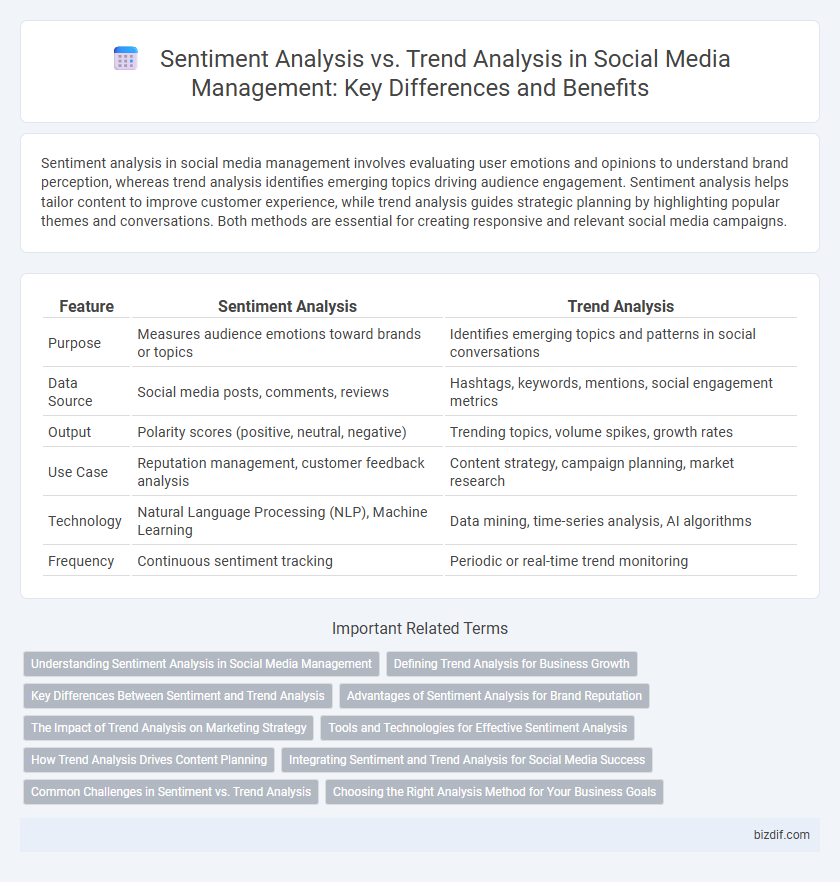Sentiment analysis in social media management involves evaluating user emotions and opinions to understand brand perception, whereas trend analysis identifies emerging topics driving audience engagement. Sentiment analysis helps tailor content to improve customer experience, while trend analysis guides strategic planning by highlighting popular themes and conversations. Both methods are essential for creating responsive and relevant social media campaigns.
Table of Comparison
| Feature | Sentiment Analysis | Trend Analysis |
|---|---|---|
| Purpose | Measures audience emotions toward brands or topics | Identifies emerging topics and patterns in social conversations |
| Data Source | Social media posts, comments, reviews | Hashtags, keywords, mentions, social engagement metrics |
| Output | Polarity scores (positive, neutral, negative) | Trending topics, volume spikes, growth rates |
| Use Case | Reputation management, customer feedback analysis | Content strategy, campaign planning, market research |
| Technology | Natural Language Processing (NLP), Machine Learning | Data mining, time-series analysis, AI algorithms |
| Frequency | Continuous sentiment tracking | Periodic or real-time trend monitoring |
Understanding Sentiment Analysis in Social Media Management
Sentiment analysis in social media management involves using natural language processing to identify and categorize emotions in user-generated content, helping brands gauge public opinion and customer satisfaction. Unlike trend analysis, which tracks popular topics and emerging patterns, sentiment analysis provides deep insights into consumer attitudes, enabling targeted responses and proactive reputation management. Accurate sentiment detection supports strategic decisions by highlighting emotional drivers behind customer behavior on various social platforms.
Defining Trend Analysis for Business Growth
Trend analysis in social media management involves examining patterns and shifts in online conversations, hashtags, and user engagement over time to identify emerging topics relevant to a brand or industry. This strategic approach helps businesses anticipate market demands, tailor marketing campaigns, and enhance product development by focusing on what resonates with target audiences. By leveraging data-driven insights from trend analysis, companies can optimize their social media presence to drive sustainable business growth.
Key Differences Between Sentiment and Trend Analysis
Sentiment analysis evaluates emotions and opinions expressed in social media content to gauge public perception, while trend analysis identifies emerging topics and patterns over time to spot shifts in audience interests. Sentiment analysis leverages natural language processing techniques to classify content as positive, negative, or neutral, whereas trend analysis utilizes data aggregation and temporal mapping to track frequency and growth of keywords or hashtags. Both approaches provide complementary insights for social media management, with sentiment analysis focusing on emotional tone and trend analysis emphasizing topic popularity and momentum.
Advantages of Sentiment Analysis for Brand Reputation
Sentiment analysis provides brands with real-time insights into customer emotions, enabling swift response to negative feedback and enhancing brand reputation management. It allows identification of underlying customer feelings, which helps tailor communication strategies effectively and foster stronger customer loyalty. This emotional understanding surpasses trend analysis, offering a deeper, nuanced view essential for maintaining a positive brand image in dynamic social media environments.
The Impact of Trend Analysis on Marketing Strategy
Trend analysis in social media management enables marketers to identify emerging topics and consumer interests in real time, providing actionable insights to shape dynamic marketing strategies. By leveraging trend data, brands can optimize content creation, allocate budgets more effectively, and increase engagement by aligning campaigns with current audience preferences. This proactive approach contrasts with sentiment analysis, which primarily gauges consumer emotions, positioning trend analysis as a crucial tool for strategic foresight and competitive advantage.
Tools and Technologies for Effective Sentiment Analysis
Sentiment analysis tools leverage natural language processing (NLP) and machine learning algorithms to accurately interpret and classify emotions in social media content, enhancing brand reputation management. Technologies like IBM Watson, Google Cloud Natural Language API, and Lexalytics provide deep sentiment insights by analyzing textual nuances and contextual meanings. These tools outperform traditional trend analysis software by focusing on emotional tone, enabling businesses to respond proactively to customer feedback and emerging sentiments.
How Trend Analysis Drives Content Planning
Trend analysis identifies emerging topics and shifts in audience behavior by monitoring hashtags, keywords, and engagement patterns across platforms. Leveraging this data enables social media managers to align content strategies with current interests, maximizing reach and user interaction. Integrating trend insights into content planning supports proactive campaign development and responsive audience engagement.
Integrating Sentiment and Trend Analysis for Social Media Success
Integrating sentiment analysis and trend analysis enhances social media management by providing a comprehensive understanding of audience emotions and emerging topics, enabling brands to tailor content effectively. Sentiment analysis deciphers user feelings from posts and comments, while trend analysis identifies popular themes and hashtags driving engagement. Combining these insights allows marketers to craft timely, emotionally resonant campaigns that increase reach and foster stronger community connections.
Common Challenges in Sentiment vs. Trend Analysis
Sentiment analysis often struggles with the nuances of language such as sarcasm, slang, and context-dependent expressions, leading to inaccurate emotional categorization. Trend analysis faces challenges in filtering out noise from vast data sources and distinguishing between short-lived spikes and sustained interests. Both methods require sophisticated algorithms and continuous updating to adapt to evolving language and cultural contexts in social media data.
Choosing the Right Analysis Method for Your Business Goals
Sentiment analysis provides insights into consumer emotions and opinions by evaluating social media content, which is essential for brand reputation management and customer feedback. Trend analysis identifies emerging patterns and popular topics over time, helping businesses capitalize on market opportunities and stay ahead of competitors. Selecting the appropriate method depends on whether your business aims to understand audience sentiment or track evolving market trends to drive strategic decisions.
sentiment analysis vs trend analysis Infographic

 bizdif.com
bizdif.com